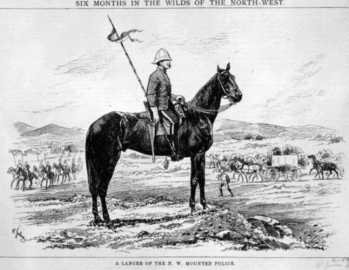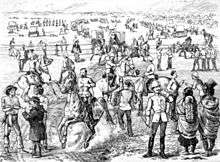March West
The North-West Mounted Police (NWMP) made their initial journey to the Canadian prairies in March West, between July 8 and October 9 1874. The force was deployed to the Alberta border in response to the Cypress Hills Massacre and subsequent fears of a United States military intervention. Their ill-planned and arduous journey of nearly 900 miles (1,400 km) became known as the "March West" and was later portrayed by the force as an epic journey of endurance.

Background

Sir John Macdonald acquired approval for his new force on May 23 1873, after Parliament, following a cursory debate, passed the Mounted Police Act into law unopposed.[1] At this point, Macdonald appears to have intended to create a force of mounted police to watch "the frontier from Manitoba to the foot of the Rocky Mountains", probably with its headquarters in Winnipeg.[2] He was heavily influenced by the model of the Royal Irish Constabulary, which combined aspects of a traditional military unit with the judicial functions of the magistrates' courts, and believed that the new force should be able to provide a local system of government in otherwise ungoverned areas.[3] Macdonald had originally also wanted to form units of Métis policemen, commanded by white Canadian officers in a similar manner to the British Indian Army, but he was forced to abandon this approach after the Métis revolt of 1870 called their loyalty into question.[4]
In June 1873, around 30 members of the Assiniboine First Nation were killed in the Cypress Hills Massacre, creating a national furore.[5] In response, Macdonald used a privy council order to enact the new legislation, formally creating the North West Mounted Police with the intention of mobilising the force and deploying it early the next year.[6] A report then arrived from Alexander Morris, the Lieutenant Governor of the North-West Territories, blaming the massacre on the activities of whiskey traders at Fort Whoop-Up; Morris predicted that if action was not taken immediately, there would be a major uprising by the First Nations across the region, into which the United States might choose to intervene.[7] Macdonald was not entirely convinced by the governor's analysis, but nonetheless he agreed to recruit 150 men and send them west to Lower Fort Garry before winter weather blocked the route.[8]
Macdonald's Conservative government then fell from power over the Pacific Scandal,(Macdonald resigned as prime minister on 5 November 1873). and was replaced by the Liberal administration of Alexander Mackenzie, who placed more credence on Morris's reports and had his own moral concerns about the whiskey trade.[9] These worries were amplified by calls from Washington for Ottawa to secure the frontier and so prevent American Indians from purchasing whiskey in Canada.[10] Mackenzie initially suggested sending a joint Canadian-United States military expedition, but, after the Governor General and others noted the serious implications of inviting the United States Army to deploy into Canadian territory, he instead agreed to deploy the new mounted police to carry out the operation.[11] Another 150 men were recruited in eastern Canada and sent west by rail through the United States to rendezvous with the first part of the force at Fort Dufferin.[12]
Deployment
The force was given orders to proceed to Fort Edmonton in order to resolve problems around Fort Whoop-Up, before then dispersing to various posts stretching westwards across the territories.[13] From Fort Dufferin, one option was to trace the southern line of the frontier, following a well-established trail created two years before by the British and United States Boundary Commission.[14] Morris disagreed with this approach, arguing that it might encourage an attack by the Sioux First Nation, and encouraged the NWMP to take a more northerly route.[15] French finally agreed with Morris that the expedition would initially follow the trail, but would then steer away from the border and Sioux territory.[16]
The march

The NWMP finally left Dufferin on 8 July 1874.[17] The 275 strong expedition was divided into six divisions, labelled A to F, supported by 310 horses, 143 draught oxen and 187 Red River carts and wagons, stretching out at least 1.5 miles (2.4 km) along the track.[18] The force took two field guns and two mortars for protection, cattle to use as food, and mowing machines for making hay.[19] French had negotiated with the Canadian Illustrated News that the expedition be accompanied by Henri Julien, a journalist whom the Commissioner hoped would write a positive account of the new force.[20]
The teams made only 15 or miles a day at most, travelling under unpleasant and arduous conditions, made more difficult by the NWMP teamsters having little experience and the horses being unsuitable for draught work.[21] On 29 July, the badly depleted A division, including those men suffering from dysentery, was left behind as the main force turned off the southerly trail and across the much drier and rougher plains to the north-west.[22] Food began to run out and, due to the expedition having failed to bring any water bottles, the men had no option but to drink contaminated local water.[23] Another detachment of the sicker men and livestock were left behind at Old Wives Lakes.[24] On 24 August the expedition reached the Cypress Hills, where the weather turned wet and cold, and the expedition's horses began to die.[25]
French had thought Fort Whoop-Up would be found at the junction of the Bow and South Saskatchewan rivers, but when they arrived on 10 September there was nothing to be seen, as the fort was in fact around 75 miles (121 km) away.[26] The NWMP had expected the area to contain good grazing for their horses but it was barren and treeless.[27] French described it as "little better than a desert" and his men were reduced to drinking muddy water gathered from marshland.[28] Having sent out search parties with no success, the expedition now faced the total loss of their horses and imminent starvation.[29]
French abandoned the plan to move further towards Whoop-Up and instead travelled 70 miles south towards the Sweet Grass Hills, close to the border, where supplies could be bought from the United States.[30] Yet more horses died from the cold and hunger and many of the men were barefoot and in rags when they arrived, having travelled a total of nearly 900 miles (1,400 km).[31]
After resupplying, French sent divisions D and E back east, before taking B, C and F to travel to Fort Whoop-Up.[32] The expedition had been badly planned and executed, and almost failed; Baker describes it as "a monumental fiasco of poor planning, ignorance, incompetence, and cruelty to men and beasts".[33]
Conclusion
When the police arrived at Fort Whoop-Up on 9 October, they were prepared for a battle, but the whiskey traders were aware that they were coming and had long since moved on.[34] The NWMP had received new orders from Ottawa to garrison the area and settled down to build Fort Macleod on an island in Old Man's River.[35]
Legacy
Early historians of the force stressed the epic nature of the expedition. The popular historian Arthur Haydon, for example, scorned the newspaper accounts which blamed the officers and men as "incapable", "inexperienced" and "careless", arguing that the march was "truly one of the most extraordinary on record", of which "all Canadians might well feel proud.[36] By 1955, however, the historian Paul Sharp had suggested that the March West almost failed due to "misinformation, inexperience and ignorance" and criticism of the force's performance intensified after 1973.[37] Ronald Atkin concludes that the expedition was "epic in its lack of organisation, in the poor way in which it was conducted and its incredibly close brush with disaster", Daniel Francis condemns it as "a fiasco of bad planning", with R. C. Macleod observing that "the difficulties of the Long March...were largely self-inflicted".[38] Nonetheless, it rapidly became portrayed by the force as epic story of bravery, endurance and determination.[39]
References
- Horrall 1973, p. 21; Horrall 1974, p. 17; Macleod 1976, p. 15
- Horrall 1974, p. 17
- Horrall 1974, pp. 15, 17; Macleod 1976, pp. 18-19
- Macleod 1976, pp. 8-9
- Horrall 1974, pp. 17-18
- Horrall 1974, p. 18
- Horrall 1973, p. 21; Horrall 1974, p. 18
- Horrall 1974, p. 18
- Horrall 1974, pp. 18-19
- Horrall 1974, p. 19
- Horrall 1974, pp. 19-20 Macleod 1976, p. 17
- Horrall 1974, p. 20
- Horrall 1974, pp. 20-21
- Horrall 1974, pp. 20-21; Stanley 1974, p. 34
- Horrall 1974, p. 20
- Horrall 1974, pp. 20-21
- Atkin 1973, p. 60
- Atkin 1973, p. 61; Stanley 1974, p. 27
- Atkin 1973, p. 61
- Stanley 1974, p. 30
- Atkin 1973, p. 63; Stanley 1974, pp. 34-35
- Atkin 1973, p. 66-67; Stanley 1974, p. 39
- Atkin 1973, pp. 67-68
- Atkin 1973, p. 69
- Atkin 1973, pp. 69, 72
- Atkin 1973, p. 73; Stanley 1974, p. 41
- Atkin 1973, p. 73; Horrall 1974, p. 23; Stanley 1974, p. 43
- Atkin 1973, p. 73; Horrall 1974, p. 23; Stanley 1974, p. 43
- Atkin 1973, p. 73; Horrall 1974, p. 23
- Atkin 1973, pp. 73-74; Horrall 1974, p. 23
- Atkin 1973, pp. 73-74, 84; Horrall 1974, p. 13
- Atkin 1973, p. 74
- Atkin 1973, p. 60; Baker 1998, p. ix
- Horrall 1974, p. 25; Atkin 1973, p. 60
- Horrall 1974, p. 24
- Haydon 1926, pp. 32–33
- Horrall 1974, pp. 14–15
- Atkin 1973, p. 60; Francis 1997, p. 32; Macleod 1976, p. 23
- Horrall 1974, pp. 13–14; Macleod 1976, p. 23
Bibliography
- Atkin, Ronald (1973). Maintain the Right: The Early History of the North West Mounted Police, 1873-1900. London, UK and Basingstoke, UK: Macmillan. ISBN 9780333122822.CS1 maint: ref=harv (link)
- Baker, William (1998). "Twenty-five Years After: Mounted Police Historiography Since the 1973-74 Centennial of the Force". In Baker, William (ed.). The Mounted Police and Prairie Society, 1873-1919. Regina, Canada: Canadian Plains Research Centre, University of Regina. pp. vii–xvi. ISBN 0889771030.CS1 maint: ref=harv (link)
- Francis, Daniel (1997). National Dreams: Myth, Memory, and Canadian History. Vancouver, Canada: Arsenal Pulp Press. ISBN 1551520435.CS1 maint: ref=harv (link)
- Haydon, Arthur L. (1926) [1910]. The Riders of the Plains: A Record of the Royal North-West Mounted Police of Canada (6th ed.). London, UK and New York, US: Andrew Melrose. OCLC 25798772.CS1 maint: ref=harv (link)
- Horrall, Stanley W. (1973). The Pictorial History of the Royal Canadian Mounted Police. Toronto, Canada: McGraw-Hill Ryerson. ISBN 9780070773660.CS1 maint: ref=harv (link)
- Horrall, Stanley W. (1974). "The March West". In Dempsey, Hugh A. (ed.). Men in Scarlet. Lincoln, U.S.: Historical Society of Alberta and McClelland and Stewart West. pp. 13–26. OCLC 635848375.CS1 maint: ref=harv (link)
- Macleod, R. C. (1976). The North-West Mounted Police and Law Enforcement, 1873-1905. Toronto, Canada and Buffalo, US: University of Toronto Press. ISBN 0802053335.CS1 maint: ref=harv (link)
- Stanley, George F. G. (1974). "The Man Who Sketched the Great March". In Dempsey, Hugh A. (ed.). Men in Scarlet. Lincoln, U.S.: Historical Society of Alberta and McClelland and Stewart West. pp. 27–49. OCLC 635848375.CS1 maint: ref=harv (link)